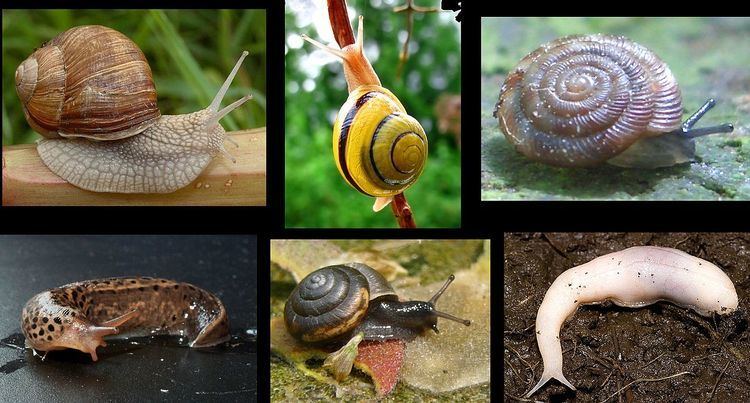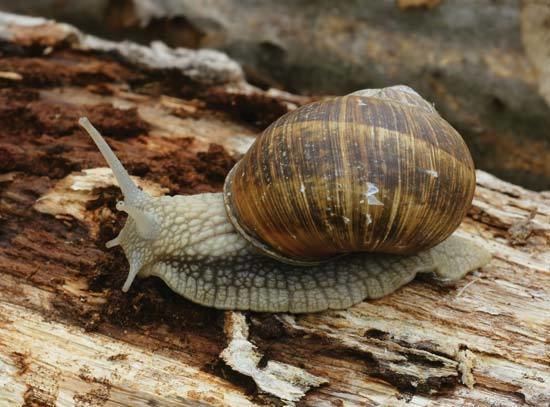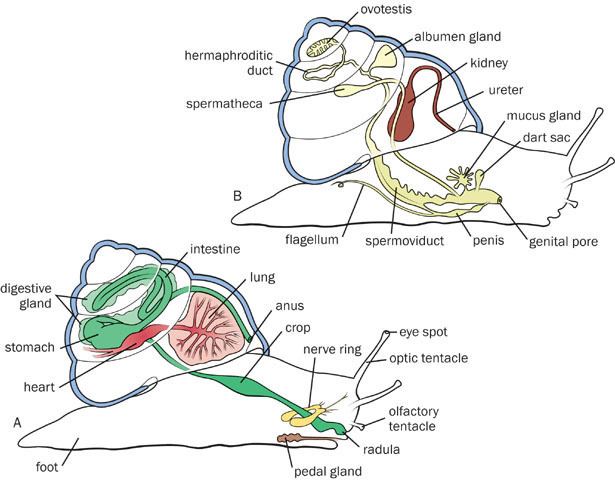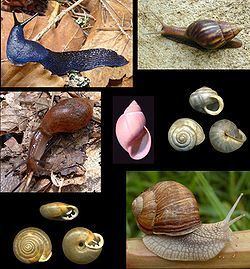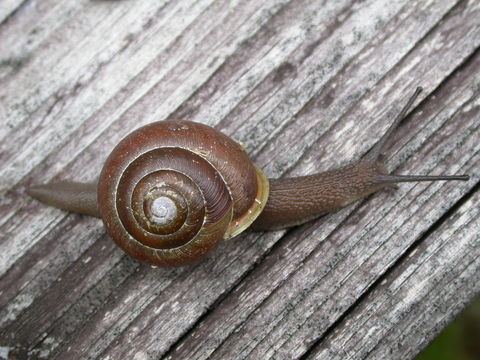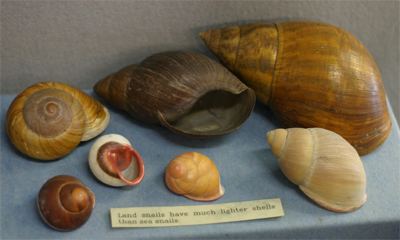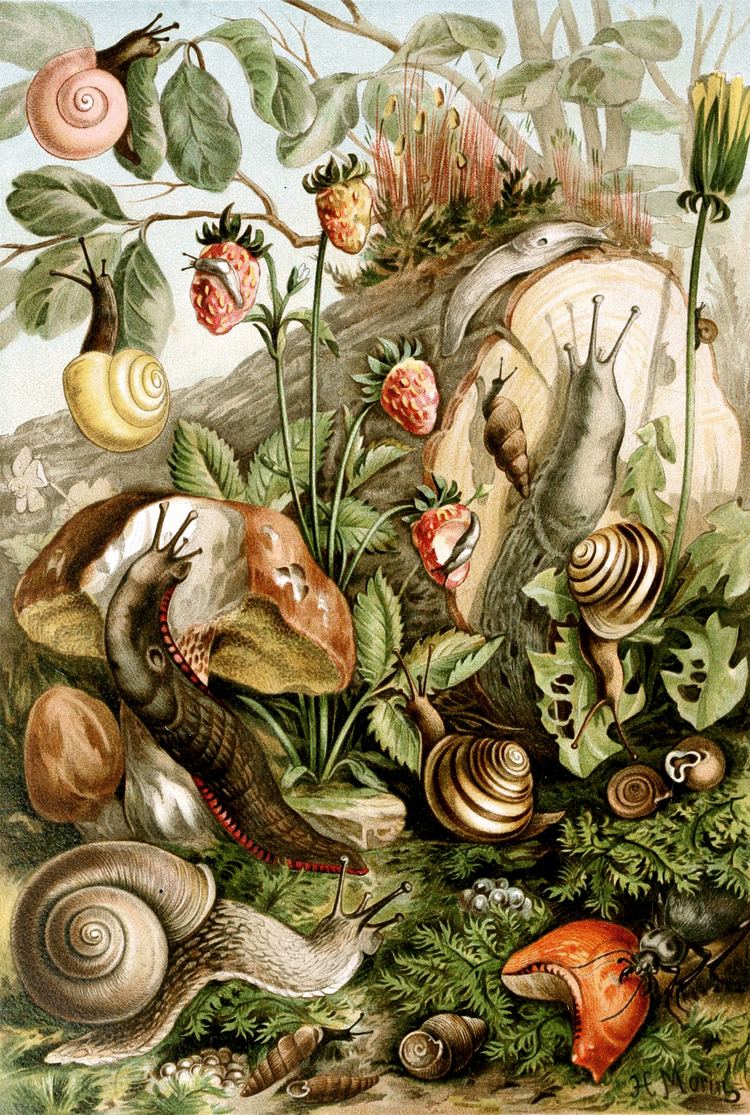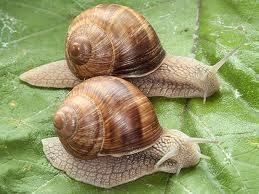Pulmonata , or "pulmonates", is an informal group (previously an order , and before that a subclass) of snails and slugs characterized by the ability to breathe air, by virtue of having a pallial lung instead of a gill , or gills. The group includes many land and freshwater families, and several marine families.
The taxon Pulmonata as traditionally defined was found to be polyphyletic in a molecular study per Jörger et al. , dating from 2010.
Pulmonata are known from the Carboniferous Period to the present.
Pulmonates have a single atrium and kidney, and a concentrated, symmetrical, nervous system. The mantle cavity is located on the right side of the body, and lacks gills, instead being converted into a vascularised lung. Most species have a shell, but no operculum , although the group does also include several shell-less slugs. Pulmonates are hermaphroditic, and some groups possess love darts .
The taxonomy of this group according to the taxonomy of the Gastropoda (Ponder & Lindberg, 1997) was as follows:
Order Pulmonata Cuvier in Blainville, 1814 - pulmonates
Suborder Systellommatophora Pilsbry, 1948 Superfamily Onchidioidea Rafinesque, 1815 Superfamily Otinoidea H. & A. Adams, 1855 Superfamily Rathouisioidea Sarasin, 1889 Suborder Basommatophora Keferstein in Bronn, 1864 - freshwater pulmonates, pond snails Superfamily Acroloxoidea Thiele , 1931 Superfamily Amphiboloidea J.E. Gray, 1840 Superfamily Chilinoidea H. & A. Adams, 1855 Superfamily Glacidorboidea Ponder, 1986 Superfamily Lymnaeoidea Rafinesque, 1815 Superfamily Planorboidea Rafinesque, 1815 Superfamily Siphonarioidea J.E. Gray, 1840 Suborder Eupulmonata Haszprunar & Huber, 1990 Infraorder Acteophila Dall, 1885 = formerly Archaeopulmonata Superfamily Melampoidea Stimpson, 1851 Infraorder Trimusculiformes Minichev & Starobogatov, 1975 Superfamily Trimusculoidea Zilch, 1959 Infraorder Stylommatophora A. Schmidt, 1856 - land snails Subinfraorder Orthurethra Superfamily Achatinelloidea Gulick, 1873 Superfamily Cochlicopoidea Pilsbry, 1900 Superfamily Partuloidea Pilsbry, 1900 Superfamily Pupilloidea Turton, 1831 Subinfraorder Sigmurethra Superfamily Acavoidea Pilsbry, 1895 Superfamily Achatinoidea Swainson, 1840 Superfamily Aillyoidea Baker, 1960 Superfamily Arionoidea J.E. Gray in Turnton, 1840 Superfamily Buliminoidea Clessin, 1879 Superfamily Camaenoidea Pilsbry, 1895 Superfamily Clausilioidea Mörch , 1864 Superfamily Dyakioidea Gude & Woodward, 1921 Superfamily Gastrodontoidea Tryon, 1866 Superfamily Helicoidea Rafinesque, 1815 Superfamily Helixarionoidea Bourguignat, 1877 Superfamily Limacoidea Rafinesque, 1815 Superfamily Oleacinoidea H. & A. Adams, 1855 Superfamily Orthalicoidea Albers-Martens, 1860 Superfamily Plectopylidoidea Moellendorf, 1900 Superfamily Polygyroidea Pilsbry, 1894 Superfamily Punctoidea Morse, 1864 Superfamily Rhytidoidea Pilsbry, 1893 Superfamily Sagdidoidera Pilsbry, 1895 Superfamily Staffordioidea Thiele , 1931 Superfamily Streptaxoidea J.E. Gray, 1806 Superfamily Strophocheiloidea Thiele, 1926 Superfamily Trigonochlamydoidea Hese, 1882 Superfamily Zonitoidea Mörch , 1864 ? Superfamily Athoracophoroidea P. Fischer, 1883 = Tracheopulmonata ? Superfamily Succineoidea Beck, 1837 = Heterurethra The taxonomy of this group according to the taxonomy of the Gastropoda (Bouchet & Rocroi, 2005) was as follows:
Contains the informal group Basommatophora and the clade Eupulmonata
Contains the clade Hygrophila
Superfamily Amphiboloidea Family Amphibolidae Superfamily Siphonarioidea Family Siphonariidae † Family Acroreiidae Clade Hygrophila Superfamily Chilinoidea Family Chilinidae Family Latiidae Superfamily Acroloxoidea Family Acroloxidae Superfamily Lymnaeoidea Family Lymnaeidae Superfamily Planorboidea Family Planorbidae Family Physidae
Contains the clades Systellommatophora and Stylommatophora
Superfamily Trimusculoidea Family Trimusculidae Superfamily Otinoidea Family Otinidae Family Smeagolidae Superfamily Ellobioidea Family Ellobiidae Superfamily Onchidioidea Family Onchidiidae Superfamily Veronicelloidea Family Veronicellidae Family Rathouisiidae Clade Stylommatophora Contains the subclades Elasmognatha , Orthurethra and the informal group Sigmurethra
Superfamily Succineoidea Family Succineidae Superfamily Athoracophoroidea Family Athoracophoridae Superfamily Partuloidea Family Partulidae Family Draparnaudiidae Superfamily Achatinelloidea Family Achatinellidae Superfamily Cochlicopoidea Family Cochlicopidae Family Amastridae Superfamily Pupilloidea Family Pupillidae Family Argnidae Family Chondrinidae † Family Cylindrellinidae Family Lauriidae Family Orculidae Family Pleurodiscidae Family Pyramidulidae Family Spelaeodiscidae Family Strobilopsidae Family Valloniidae Family Vertiginidae Superfamily Enoidea Family Enidae Family Cerastidae Superfamily Clausilioidea Family Clausiliidae † Family Anadromidae † Family Filholiidae † Family Palaeostoidae Superfamily Orthalicoidea Family Orthalicidae Family Cerionidae Family Coelociontidae † Family Grangerellidae Family Megaspiridae Family Placostylidae Family Urocoptidae Superfamily Achatinoidea Family Achatinidae Family Ferussaciidae Family Micractaeonidae Family Subulinidae Superfamily Aillyoidea Family Aillyidae Superfamily Testacelloidea Family Testacellidae Family Oleacinidae Family Spiraxidae Superfamily Papillodermatoidea Family Papillodermatidae Superfamily Streptaxoidea Family Streptaxidae Superfamily Rhytidoidea Family Rhytididae Family Chlamydephoridae Family Haplotrematidae Family Scolodontidae Superfamily Acavoidea Family Acavidae Family Caryodidae Family Dorcasiidae Family Macrocyclidae Family Megomphicidae Family Strophocheilidae Superfamily Punctoidea Family Punctidae † Family Anastomopsidae Family Charopidae Family Cystopeltidae Family Discidae Family Endodontidae Family Helicodiscidae Family Oreohelicidae Family Thyrophorellidae Superfamily Sagdoidea Family Sagdidae limacoid clade Superfamily Staffordioidea Family Staffordiidae Superfamily Dyakioidea Family Dyakiidae Superfamily Gastrodontoidea Family Gastrodontidae Family Chronidae Family Euconulidae Family Oxychilidae Family Pristilomatidae Family Trochomorphidae Fossil taxa probably belonging to the Gastrodontoidea Subfamily † Archaeozonitinae Subfamily † Grandipatulinae Subfamily † Palaeoxestininae Superfamily Parmacelloidea Family Parmacellidae Family Milacidae Family Trigonochlamydidae Superfamily Zonitoidea Family Zonitidae Superfamily Helicarionoidea Family Helicarionidae Family Ariophantidae Family Urocyclidae Superfamily Limacoidea Family Limacidae Family Agriolimacidae Family Boettgerillidae Family Vitrinidae other Sigmurethra Two superfamilies belongs to clade Sigmurethra, but they are not in the limacoid clade.
Superfamily Arionoidea Family Arionidae Family Anadenidae Family Ariolimacidae Family Binneyidae Family Oopeltidae Family Philomycidae Superfamily Helicoidea Family Helicidae Family Bradybaenidae Family Camaenidae Family Cepolidae Family Cochlicellidae Family Elonidae Family Epiphragmophoridae Family Halolimnohelicidae Family Helicodontidae Family Helminthoglyptidae Family Humboldtianidae Family Hygromiidae Family Monadeniidae Family Pleurodontidae Family Polygyridae Family Sphincterochilidae Family Thysanophoridae Family Trissexodontidae Family Xanthonychidae Jörger et al. (2010) analyzed major groups within the Heterobranchia using genetic data and found that Pulmonata as traditionally defined was polyphyletic, for instance some pulmonates were more closely related to Sacoglossa and Acochlidia. They proposed the more inclusive taxon Panpulmonata to unite the clades Siphonarioidea, Sacoglossa , Glacidorboidea, Pyramidelloidea , Amphiboloidea, Hygrophila, Acochlidia and Eupulmonata .
